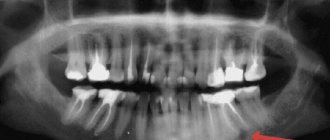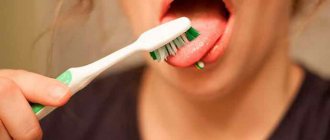Dental diseases in dogs are caused by the fact that it is quite difficult for them to maintain oral hygiene. One possible complication is flux. This is a very painful condition, so any owner wants to help their pet as quickly and effectively as possible. To provide assistance in the initial stages, you need to know the symptoms and methods of treating a dog with flux.
What is tooth flux in dogs?
Flux in veterinary medicine is called periostitis. This is an infectious disease manifested by inflammation near the periosteum. The word “periostitis” itself comes from the Greek language and is translated as peri – “near”, osteon – “bone”. That is, this is an inflammatory process “around the bone.”
The formation of flux in a dog can be seen with the naked eye if you examine the animal’s jaw. When it appears, you should not postpone a visit to the veterinarian, since delay can lead to dangerous consequences - deformation of the jaw bone, tooth loss and even sepsis.
Why does flux form?
Dental diseases are always the precursor to gumboil. Most often lead to suppuration:
- Untreated caries. If caries is not treated, the inflammatory process begins to spread to other tissues. Pulpitis and periodontitis gradually develop.
- Mechanical injury. Injury can lead to more than just crown destruction. Very often, an inflammatory process develops in injured tooth or gum tissues. Without treatment, purulent processes develop and gumboil forms.
- Periodontitis. In more than half of the cases, gumboil develops precisely against the background of periodontitis, as its complication. This is due to the fact that purulent processes from periodontal pockets can spread to the neck of the tooth.
- Poorly sealed canals. Before filling, the canals must be completely cleaned and the filling material must completely fill the cavity. If at least one of the conditions is violated, the infection from the canal spreads to other tissues.
Causes of the disease
The primary cause of gum inflammation in dogs is considered to be poor oral hygiene. The animal needs to brush its teeth and also monitor their health; if a stone appears, contact a veterinary clinic for its timely removal.
Flux can also be a complication of other pathologies: gingivitis, pulpitis, periodontitis.
One of the causes of gumboil in dogs is considered to be a secondary infection after the removal of a diseased tooth. After surgery, proper care of the dog’s oral cavity is required to avoid infection and inflammation of the periosteum.
In addition, the cause of inflammation of the gums in dogs is any trauma in the muzzle area - bones, pebbles and other hard and sharp objects.
What is this?
Lymphadenitis (lymphadenopathy) is an inflammatory process affecting the lymph nodes. They perform a filtering function for lymph coming from various internal organs of the pet, and are located next to the blood vessels. That is why their inflammation poses a serious threat to the health and life of the animal.
Forms of lymphadenitis that can be diagnosed in a dog:
- Spicy. All signs of inflammation develop rapidly, and the symptoms are clearly expressed. In 9 out of 10 cases with acute lymphadenitis, the animal experiences a febrile state (increased body temperature).
- Chronic. Its main feature is the “erasure” of symptoms. They do not have the severity characteristic of lymphadenitis and arise gradually. Most often accompanied by pronounced pallor, loss of appetite, and difficulty breathing.
All dog breeds are equally prone to lymphadenitis. However, elderly pets and animals with weakened immune systems are at particular risk. Their health needs to be treated even more carefully in order to prevent dangerous consequences for the entire body.
Types of pathology
Flux in a dog can be:
- Serous - occurs due to mechanical trauma. The pet may get into a fight with another dog or hit its jaw while playing. This is a relatively mild type of pathology and, as a rule, goes away without consequences with appropriate treatment.
- Purulent - this type of flux is diagnosed if its initial stage has been missed. Pus begins to accumulate in the periosteum. In this case, immediate treatment of the pet is required, which begins with opening the abscess.
- Diffuse is a severe stage of the disease. It is considered the most dangerous of all those considered. Its course is extremely severe, and the development of sepsis is possible.
- Chronic. This development of the disease is rare and is diagnosed in dogs with significantly reduced body defenses, especially after serious illnesses.
If adequate treatment is not received on time, the flux can develop into an abscess (the second stage of inflammation, when the infection invades deeper tissues) or phlegmon (the most severe degree of the disease, when other organs are involved).
Symptoms of gumboil
Flux on the gums in adults occurs much more often than in children (approximately 80-90 percent of all cases). A characteristic feature of the pathology is that it does not go unnoticed. This is one of the most unpleasant diseases, causing severe discomfort. The most striking symptoms are the classic purulent flux.
Symptoms
- Severe throbbing pain.
- Inflammation and swelling of soft tissues. At the advanced stage, the side of the face on which the flux is diagnosed swells.
- Enlarged lymph nodes.
- Discomfort and pain when eating and talking.
- Flux of the lower tooth (in the molar area) can lead to numbness of the lip and part of the chin.
- Weakness, headache, fever.
Symptoms and signs
The owner of the animal may suspect the development of the disease when the dog wants to eat, but cannot do so. A hungry animal restlessly walks around the bowl, tries to chew food, but experiences severe pain and spits out the food. The same thing happens with water. At the same time, the dog’s entire jaw hurts.
The pet sleeps restlessly, whines, and constantly jumps up. When examining the jaw, loose teeth may be detected. There may be blood left in the bowl. The mouth smells bad, the animal is drooling, and there may be bleeding from the nose.
With the serous type of pathology, the jaw swells and the periosteum swells. In a dog, one part of the muzzle becomes larger than the other, but this is not a mandatory sign. In this case, the pet can behave as usual without experiencing pain.
With purulent inflammation of the periosteum, wounds on the gums are visible. The animal's body temperature rises, the oral cavity swells and becomes red, and profuse salivation is observed.
With diffuse flux, the dog feels heavy. The dog may lie and whine pitifully, constantly fiddling with its muzzle. The body temperature is very high, salivation is increased, and blood often flows from the mouth.
How do symptoms appear?
Symptoms may not appear at first, but the dog will experience pain immediately. As a result, her behavior will change.
Flux symptoms:
- pain;
- mild swelling on the gum;
- salivation;
- bleeding or discharge from gums or gums;
- unpleasant odor from the mouth;
- nausea;
- fever;
- ear pain; food falling out on the floor while eating;
- refusal of dry food.
Your pet may rub its face against various objects to scratch the swelling or reduce discomfort from it.
First aid at home
If the dog's condition is not serious, first aid can be provided to the animal at home before contacting a doctor. First of all, you need to give a painkiller so that the dog calms down and can eat.
Give a sick dog food that is warm and soft, so as not to further injure the already affected oral cavity.
Then you need to examine the dog's jaw. If periostitis is in the initial stage, you can give an anti-inflammatory and rinse the dog’s mouth with a decoction of sage and other anti-inflammatory herbs.
What happens if you don't undergo therapy?
It is unacceptable to treat purulent gum lesions as a minor dental disorder. It is very insidious and rarely disappears without a trace on its own. Often, if treatment is refused, the following occurs:
- Abscess. It is a consequence of a long-term presence of a pus-filled sac in the area of the tooth root. The abscess grows and then ruptures.
- Phlegmon. Represents an extended lesion. It usually occurs after a rupture of a purulent sac, if the patient does not comply with the dentist’s instructions, does not rinse the mouth with a special antiseptic solution, or apply anti-inflammatory gels.
- Osteomyelitis of the jaw. It occurs if the gums are not treated for a very long time. The pathological process spreads to the jaw bone, which is very dangerous.
- Inflammation of individual sinuses of the skull. It is also diagnosed with advanced periostitis. The maxillary, frontal and sphenoid sinuses are affected.
It is extremely rare that the disease affects brain tissue. Then the person may even die.
How to prepare a decoction for washing the jaw?
To prepare the medicine, take 60 grams of sage, St. John's wort and oak bark, brew with a liter of boiling water, leave for at least two hours, cool and treat the affected jaw every hour with moistened gauze bandages.
You can take equal amounts of sage herb and green tea and pour boiling water (2 tablespoons of the mixture per liter of water) and let it brew for a day. A little salt is added to the finished broth and the jaw is also treated. Of course, the dog will not be able to rinse his mouth with the solution, so his mouth is simply wiped with medical wipes soaked in the finished medicine.
How to speed up recovery
To make healing go faster, it is important not only to follow the dentist’s instructions, but also to remember the rules:
- do not heat the area where the pus was located;
- do not take antibiotics or any other medications unless prescribed by a doctor;
- do not use any folk recipes without consulting your doctor;
- Until the wound is completely healed, do not use aspirin or any medications that contain acetylsalicylic acid.
If the “bump” appears again, it is recommended to immediately contact a dental clinic.
When should you contact a veterinarian?
If your pet has a fairly large periostitis, and the condition is serious, the temperature is high, you should immediately take the dog to the doctor. It is the veterinarian who knows what gumboil looks like in an animal and will not confuse it with other pathologies. Only a doctor can assess the pet’s condition, make a diagnosis and prescribe treatment.
If a dog has flux on the upper jaw, this is fraught with complications including meningitis, so contacting a veterinarian is extremely necessary.
Causes of inflammation of the lymph nodes
Nonspecific inflammation of the lymph nodes develops when various pathogenic microorganisms enter the lymphatic system of the dog's body (for example, bacteria, rickettsia or viruses). In addition, the causes of the disease can be staphylococci, streptococci and E. coli. In this case, the primary source of infection can be ulcers, inflammatory processes of soft tissues, purulent wounds, as well as caries or thrombophlebitis.
In addition to nonspecific lymphadenitis, there is also specific lymphadenitis, which occurs as a complication of a serious illness in an animal (for example, tuberculosis, brucellosis, salmonellosis).
In approximately 5-7% of all visits to a veterinary clinic in Moscow, the development of lymphadenitis in a pet is provoked by other non-inflammatory factors:
- allergies due to frequent contact with an allergen,
- intoxication of the body,
- significant mechanical damage (for example, from a collar that is too tight),
- autoimmune reactions of the dog's body,
- parasitic disease
- reaction after vaccination of an animal, etc.
Diagnosis and treatment
When visiting a doctor, they first take an X-ray of the jaw and conduct laboratory tests.
For uncomplicated forms of pathology, conservative treatment is carried out with antibiotics and antiseptic solutions and ointments.
In severe cases, surgery is used. The abscess is opened under anesthesia, the oral cavity is treated with antiseptic solutions. If necessary, drainage is installed.
If the cause of the flux is a diseased tooth, it is removed. If a dog has tartar, it is also removed using ultrasound.
When do you need dental help?
Flux has pronounced symptoms. The main one is the appearance of an abscess on the gum next to the diseased tooth. The abscess develops gradually. At first, the gums swell a little and a small red or whitish bump is noticeable on it. After some time, a noticeable fistulous tract forms on the lump, from which pus flows. The development of periostitis is accompanied by other symptoms:
- Swelling and swelling of the gums, lips, cheeks. Sometimes they can be so large that facial features are distorted.
- Severe cutting pain in the tooth area. Innervates the temporal region, orbits.
- The diseased tooth begins to become very loose, even if there was no mobility before or it was insignificant.
Since flux is caused by infection, it is characterized by symptoms that appear during any infectious process. The patient feels unwell, his temperature rises, his head hurts, and weakness appears. Lymph nodes on the head and neck become enlarged.
Any of these symptoms is a reason to consult a doctor. The more advanced the case, the higher the risk of complications. This disease is often accompanied by other pathological processes. For example, a cyst may form in tissues affected by infection.
Antibiotics for flux
Antibacterials are medications that help fight bacterial infections. The cause of inflammation on the animal's gums is most often bacteria, so prescribing antibiotics for gumboil in a dog is quite justified in this case.
For periostitis, the doctor prescribes broad-spectrum drugs. Among them: “Tsiprovet”, “Amoxicillin”, “Ceftriaxone”. They may be in the form of tablets or injections.
Antibacterial medications can prevent infection from spreading throughout the body. However, their use is not a panacea. And, as soon as the pet’s condition improves, you need to start treating the animal’s teeth and gums.
Treatment of flux in a dog with antibiotics is carried out in the case of the initial stage of the pathology in order to overcome the disease. If the condition is advanced, the abscess is first surgically removed, and only then antibacterial drugs are prescribed.
A course of antibiotics must be prescribed by a doctor. Self-medication of a dog in this case is dangerous; the required doses are not so easy to calculate, so you should not risk your pet’s health.
How is lymphadenitis treated?
The key to successful treatment of lymphadenitis in a dog is contacting a reliable veterinary clinic. Here they will not only quickly and accurately make a diagnosis, but also prescribe effective therapy. In the treatment of lymphadenitis, an integrated approach is important, so the veterinarian prescribes pharmacological drugs of various spectrums of action.
Firstly, the inflammatory process is suppressed. For these purposes, a course of antibiotics is prescribed, selected by the doctor taking into account the sensitivity of the pathogenic microorganisms that provoked the development of the disease in the dog.
Secondly, hepatoprotectors (drugs intended to maintain liver function) and probiotics are prescribed. They prevent the occurrence of side effects from antibiotics, since their use must be long-term and regular.
Thirdly, a vitamin-mineral complex is prescribed. Typically, special emphasis should be placed on vitamin A (retinol), vitamin B2 (riboflavin) and vitamin C (ascorbic acid). They will help the dog’s body recover much faster from illness.
In cases where inflammation of the lymph nodes is accompanied by a purulent process, surgical treatment is prescribed. It is necessary to open the inflamed area of tissue, and then install drainage (to remove exudate). Subsequently, the rehabilitation period includes regular application of anti-inflammatory ointments and the use of drugs to strengthen the animal’s immune system.
In some cases, your pet may be prescribed physiotherapeutic procedures. For example, heat treatment (ultra-high frequency therapy) helps to quickly reduce the inflammatory response. However, it is important to consider contraindications, the main of which is the detection of malignant neoplasms (oncology).
Features of care
If a pet is diagnosed with periostitis, the owner should review the features of caring for the animal:
- First of all, provide rest to the sick animal. Any types of activity and training are kept to a minimum. Of course, this does not mean that the dog should only lie down, however, it is worth limiting its movement.
- Provide the animal with nutritious nutrition. The amount of vitamins and minerals should be sufficient. The food should contain calcium, phosphorus, and vitamin D. This will help you quickly overcome the disease and avoid complications.
The owner needs to be attentive to the pet’s condition, because sometimes a kind word can ease the animal’s suffering.
Prevention
Most often, the appearance of flux can be avoided if you carefully monitor the health of the four-legged animal. Since periostitis occurs where there is plaque and tartar, you need to regularly brush your animal's teeth.
If a stone forms, you should immediately contact a veterinarian to have it removed. It is not difficult to notice: the teeth darken at the base or acquire a yellow color.
To avoid stone formation, you should pay attention to the following points when caring for your pet:
- The dog should be given solid food every day that can be chewed. In this way, dental formations are cleaned.
- The dog's teeth should be brushed with a special brush, which can be purchased at a veterinary pharmacy.
- There are also special pastes and gels for dissolving dental plaque, which can also be used for prevention.
- Removing tartar in a veterinary clinic is the most guaranteed way to prevent the occurrence of periostitis in an animal.
In addition, at home, you can periodically wipe the four-legged gums with a solution of tea soda (a teaspoon per glass of water), and also give the dog to chew on “sugar” bones to grind down the teeth and clean them.
If the animal's diet is too soft, this can lead to caries, the untimely treatment of which causes various complications, including inflammation of the periosteum. Sometimes dog owners ask what tooth flux is in their pet. This is inflammation at its root, leading to gum swelling.
So, periostitis (flux) in a dog is a dangerous pathology, but with careful attention to the pet’s condition, it can be completely eliminated. Timely detection of the disease and contacting a veterinarian can help the animal. The main thing for the owner is to monitor the health of the dog’s oral cavity, and then it is quite possible to avoid problems in the form of gumboil.
Can complications arise?
If you promptly seek help from a veterinarian and treat your dog in accordance with his instructions, you will be able to avoid complications that arise from inflammation of the lymph nodes in animals. If this is not done, the functioning of the entire lymphatic system will be impaired, which means that the pet will lose the natural barrier that protects it from infections.
With nonspecific lymphadenitis, the following complications are possible:
- phlegmon,
- abscess,
- thrombophlebitis,
- sepsis,
- lymphostasis, etc.
The prognosis in the absence of treatment is death.










